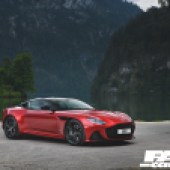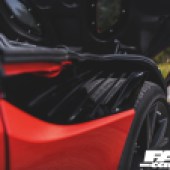The Aston Martin DBS Superleggera is the ultimate evolution of the DB11. It is also the return of the famous DBS initials, and as such has a lot to live up to. We take an Alpine drive to find out more.
Road test taken from Ultimate Supercar. Words: Tim Pitt.
The Swift Voyager is anything but. I’ve been stuck behind this meandering motorhome for miles, on a route so tortuously twisty that even 725hp isn’t enough to blast past. Then, miraculously, the road unravels and stretches out ahead: a long straight through a tunnel of trees. I won’t need telling twice. I click down two ratios with the left paddle and – woooompf – the rolling roadblock shrinks to a speck in my mirrors. Now that’s swift.

We are high in the German Alps on the launch of the Aston Martin DBS Superleggera. The lush landscape is dotted with charming chalets and bemused cows. Julie Andrews is surely on standby, ready to burst into song at any moment. The Aston Martin DBS, though, is making V12 music of its own, its gargling growl building to a chest-beating bellow that echoes along the valley.
We reach a barrier and a toll booth. The road up the mountain is private and thus traffic-free. Well, apart from several other Superleggeras queueing up behind. This could be quite special. I’m waved through and… go! The Aston catapults into a series of switchbacks, bespoke Pirelli P Zeros scrabbling for traction as 900Nm of torque hits the tarmac. The back-end breaks loose around a particularly tight hairpin, but ESC and torque vectoring (with, um, a bit of help from my driving) keep things calmly under control. Onwards and ever-upwards, my ears are popping almost as furiously as the four tailpipes.

The flow of the road is hypnotic, The Aston carves between steep-stacked corners with a fluidity that belies its bulk. Then, all too soon, we are at the summit, a gaggle of Chinese tourists reaching for their cameras as the gleaming Hyper Red DBS roars into view. It feels like a hero’s welcome, but dark clouds are gathering and, within a minute, it’s raining heavily. That’s mountain weather for you. I switch on the lights and wipers and potter steadily back downhill. Not such a hero now, it seems.
The Aston Martin DBS Superleggera is the new top tier in the DB11 range. This kicks off with the 510hp V8 – available as both coupe and Volante convertible – then steps up to the 630hp V12 AMR. For the uninitiated, AMR is Aston Martin’s new sportier sub-brand (complete with yellow go-faster stripes), but the DBS goes further still. This ‘Super GT flagship’ boasts an extra 95hp, weight-saving panels and clever aero. The result is 0-62mph in 3.4 seconds and a 211mph top speed.

A dry weight of 1693kg is hardly ‘super light’ (the rival Ferrari 812 Superfast weighs 1630kg), but the Superleggera is a useful 72kg leaner than a DB11 AMR. Most of that saving comes from carbon fibre: used for the forward-hinging clamshell bonnet, roof and tailgate. The doors, meanwhile, are aluminium and the rear wings are composite. Forged alloy wheels trim vital kilos, too – especially if you choose the Lightweight Twin Spoke option.
Aston Martin DBS: Downforce to spare
The reshaped bodywork also generates a sizeable chunk of downforce with, crucially, no drag penalty. A front splitter directs air into underbody venturis leading to a double diffuser, while the new ‘Aeroblade II’ rear spoiler – a gorgeous sliver of naked carbon fibre – stretches the width of the rear deck. Total downforce is 180kg at VMax, 110kg more than a DB11 and the highest of any series production Aston Martin. That said, an engineer at the launch revealed the forthcoming Valkyrie hypercar will develop “more than a tonne” of downforce, which somewhat puts the DBS in its place.

All the above also matters little if the end-product looks like a pooch’s petit dejeuner. After all, CEO Andy Palmer stated that “Any car we make must be the most beautiful in its class”. The DBS Superleggera is, well, a beauty from some angles, a beast from others. Its silhouette is classic post-DB7-era Aston, but details such as the ‘curlicue’ vents and ‘open stirrups’ in the front wings take inspiration from the Vulcan and Vantage GTE racer. It’s aggressive.
The styling was entrusted to Marek Reichman, who explained “It’s about describing power. Park a DBS next to a DB11 and Vantage, and anyone can tell which car is the most potent. The DB11 has a pleated Savile Row suit, while the DBS wears its shirt slightly too tight. Like Rio Ferdinand, it’s proud of its physique.” Ironically, most footballers seem to prefer Ferraris, but you get the point.

Inside, the DBS looks far more like a regular DB11: sleek and well-made, if a little haphazard ergonomically. The sweeping dashboard gains a new, more angular, instrument binnacle, plus more exposed carbon fibre and the squared-off steering wheel from the Vantage. The gearshift paddles are longer and racier ‘Sports Plus’ seats are standard, trimmed in sumptuous Scottish leather and Alcantara. An oddly Citroën-esque double chevron motif is stitched into the seats and roof lining.
Options to please
As with most six-figure cars, though, this is merely the starting point. Have a word with Aston’s archly-named ‘Q’ division and the only limits are your imagination and bank balance. Would sir like seatbelts in Flint, Champagne, Spicy Red, Mocha or Graphite? How about a carbon steering wheel, or one’s family crest embroidered onto the headrests? Sadly, you can’t upgrade the last-generation Mercedes-Benz media system, which already looks dated – and lags behind what you’d get in a new A-Class.

Not that you’ll care about infotainment when V12 rhapsody is just an ankle-flex away. Still, absolute power corrupts absolutely, so it’s a good thing Matt Becker is involved. Aston’s chief engineer worked at Lotus before being poached by Gaydon in 2015 and is the chassis wizard behind the sensational new Vantage. If anyone can make this car drive well, it’s him.
Unlike its little brother, the DBS doesn’t have a hell-for-leather Track mode. Choose instead from GT, Sport and Sport Plus, with suspension and drivetrain response configured separately via switches on the steering wheel. Adaptive damping is standard, along with a mechanical limited-slip differential (the Vantage uses an electronic ‘E-Diff), while weight distribution is a near-perfect 51:49 – helped by wedging the V12 as far back as possible beneath the scuttle.

“The key number here is 900Nm,” explains Becker with a grin. “That’s 182Nm more than the Ferrari [812 Superfast] and 150Nm more than a One-77.” On the road, it feels like a force of nature, a swell of thunderous thrust on-tap from scarcely above tickover. Yet Becker’s chassis not only copes with such demands, it relishes them. The direct, meaty steering and the way it bites into bends, nuanced and neutral unless provoked with the throttle, is akin to a bigger, brawnier Vantage. “We’ve tuned the handling to engage and reward drivers of all ability levels,” says Becker.
Speaking of ability levels, you can switch the DSC stability control off entirely, but that isn’t something I tried on greasy roads flanked by sheer cliffs. Sport Plus mode permits ‘sportier’ slip angles while still keeping you safe – plus allowing a healthy dose of third-gear wheelspin. Ahem. The standard carbon-ceramic brakes merit a mention, too, hauling the Vantage to a halt with brutal efficiency.

Supple motorway cruiser
As we follow a cascade of waterfalls up another verdant valley, Adolf Hitler’s Kehlsteinhaus (Eagle’s Nest) fortress appears in the distance, perched atop a rocky peak. Excuse the all-too-obvious metaphor, but it feels like a scene from James Bond, the DBS racing towards the villain’s lair. All I need is a Walther PPK and a leggy brunette in the passenger seat – both of which, regrettably, Aston failed to supply.
Even this British bruiser can’t scale the vertical ascent to the Nazi base, though. And besides, we need to bid auf wiedersehen to this Alpine playground and make tracks for the airport. After four hours and a full tank of super unleaded, my time with the DBS Superleggera is almost up.

Switching to GT mode, we settle to a comfortable cruise. Here, on more mundane roads, the Aston’s inner DB11 comes to the fore. Its suspension is supple, its eight-speed gearbox smooth, and its power delivery utterly effortless. It even sounds sedate when you aren’t pressing on, the exhaust baffles muffling any fireworks. This is the stuff Aston Martin has always done well, and it hasn’t forgotten its roots.
Lest we forget, of course, the DBS is a ‘super GT’. The role of ‘super sports car’ will be filled by the 2021 Vanquish, a mid-engined answer to the Ferrari 488 GTB and McLaren 720S. That gives this car a tough brief: to meet the demands of keen drivers and offer long-distance comfort. We would happily have driven it back from the Alps to London – via some autobahns, of course – then carried on to north Wales just for the hell of it. You wouldn’t contemplate that in a Caterham.

Glorious GT and scintillating sports car, the DBS Superleggera is sure-fire success from a revitalised Aston Martin. Roll on the Valkyrie and Vanquish.
Tech Spec: Aston Martin DBS Superleggera
Engine: Twin-turbo V12, front-mounted, 5.2-litre
Transmission: Eight-speed semi-auto, rear-wheel drive
Chassis: Bonded aluminium body, carbon fibre and composite panels
Suspension: Double wishbones front, multi-link rear, adaptive damping
Wheels: 21in alloys
Tyres: 265/35/21 (front), 305/30/20 (rear)
Brakes: Carbon-ceramic discs; 410mm front, 360mm rear
Power: 725hp@6500rpm
Torque: 900Nm@1800-5000rpm
0-62mph: 3.4 seconds
Top speed: 211mph
Fuel economy: 22.9mpg
CO2 emissions: 285g/km
Price: £225,000



















